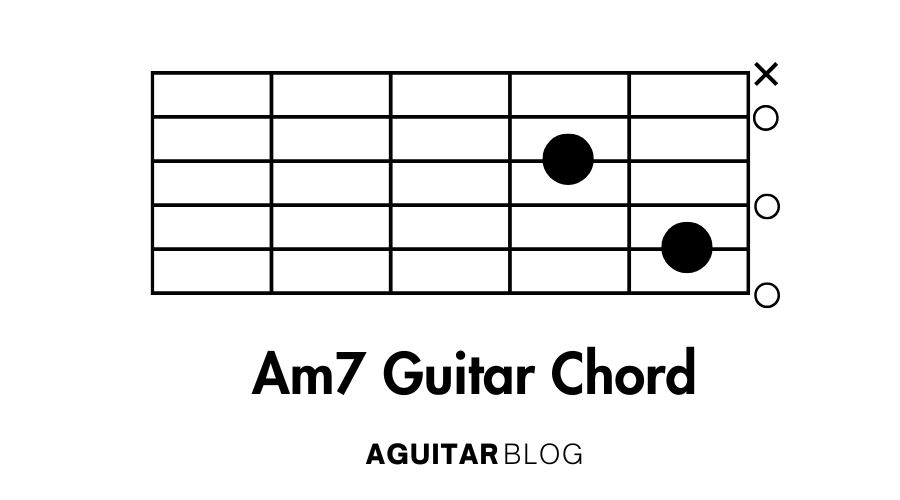The Am7 guitar chord (A minor 7) is a popular chord used across various genres, from jazz and blues to rock and pop. It has a rich, mellow sound that adds depth and emotion to your playing. Whether you are a beginner or an advanced guitarist, mastering the Am7 chord is essential for expanding your musical vocabulary.
In this guide, we’ll walk you through how to play the Am7 chord, its variations, and how to use it in different musical contexts.
What is the Am7 Guitar Chord?
The Am7 chord is a minor seventh chord, made up of four notes:
- A (the root note)
- C (the minor third)
- E (the perfect fifth)
- G (the minor seventh)
The Am7 chord has a deep, emotional sound with a slight tension, making it a versatile addition to many chord progressions.
How to Play the Am7 Guitar Chord

Open Position (Basic Am7)
The most common and easiest way to play the Am7 chord is in the open position:
- Place your index finger on the 1st fret of the 2nd string (B string).
- Place your middle finger on the 2nd fret of the 4th string (D string).
- Leave the A string (5th string) open.
- Do not press on the low E string (6th string), as it is not part of the chord.
Strum from the 5th string (A string) down to the high E string. You can also add a light palm mute to add texture to your strumming.
Am7 Barre Chord Variations
Once you’re comfortable with the open position, try these barre chord variations:
Am7 (5th Fret Barre Chord)
- Barre all six strings at the 5th fret with your index finger.
- Place your ring finger on the 7th fret of the 4th string (D string).
- Place your pinky finger on the 7th fret of the 3rd string (G string).
- Strum all six strings for a full sound.
Am7 (12th Fret Barre Chord)
- Barre all strings at the 12th fret with your index finger.
- Place your middle finger on the 13th fret of the 4th string (D string).
- Strum from the 6th string to the high E string for a high-pitched version of the Am7 chord.
Am7 Chord Variations and Extensions
To make your sound richer and more dynamic, you can experiment with these variations of the Am7 chord:
- Am9: Add the B note (9th) to the Am7 chord for a jazzy, smooth sound.
- Am11: Add the D note (11th) for a fuller, more complex sound.
- Am7/G: Play the Am7 chord with a G bass note (usually by playing the 3rd fret of the low E string).
- Am7b5 (A minor seven flat five): Lower the fifth note (E to Eb) for a diminished sound that works well in jazz and blues.
Video Tutorial Am7 Guitar Chord
For visual learners, a step-by-step video tutorial can make mastering the Am7 Guitar Chord much easier. Here’s a helpful guide for you:
Common Chord Progressions Featuring Am7
The Am7 chord is often used in chord progressions that involve minor and major seventh chords. Here are some examples:
- Am7 – Dm7 – G7 – Cmaj7 (Jazz progression)
- Am7 – Fmaj7 – G7 (Soul and R&B progression)
- Am7 – Cmaj7 – Fmaj7 – E7 (Pop or folk progression)
Popular Songs That Use the Am7 Chord
The Am7 chord is featured in numerous songs across different genres. Here are a few examples:
- “Let It Be” by The Beatles
- “No Woman, No Cry” by Bob Marley
- “Human Nature” by Michael Jackson
Tips for Practicing the Am7 Guitar Chord
Beginner Tips:
- Focus on clarity: Make sure each note rings clearly. The Am7 chord has a distinct, mellow sound, so practice pressing down each string evenly.
- Chord transitions: Practice moving between Am7 and other common chords, such as Dm7, G7, and Cmaj7, to improve fluidity.
- Use a metronome: Practice strumming the Am7 chord in time to a metronome to keep your rhythm steady.
Advanced Tips:
- Explore barre chord shapes: Try barre chords for Am7 in different positions (5th fret, 12th fret) to expand your range.
- Fingerpicking: Try fingerpicking each note of the chord to create a more intricate, dynamic sound.
Common Mistakes to Avoid
- Muted Strings: Be mindful of finger placement to avoid muting strings that should ring out. Ensure that your fingers are pressing the strings just behind the frets.
- Incorrect Barre Technique: When playing barre chord versions, ensure that you press down firmly and evenly with your index finger to avoid buzzing or muted notes.
- Strumming the Low E String: Avoid hitting the low E string when playing the open position Am7 chord.
Related Chords to Am7
- Am (A minor): A simpler version of Am7 without the G note.
- Dm7: Often paired with Am7 in progressions.
- G7: A dominant seventh chord that complements Am7 well in blues and jazz progressions.
Conclusion
The Am7 guitar chord is a key element in many styles of music, thanks to its emotional depth and versatility. Whether you’re using it in a jazz progression or a pop ballad, mastering the Am7 chord will enhance your guitar skills and open up new creative possibilities.
Keep practicing, experiment with variations, and enjoy adding the smooth, soulful sound of Am7 to your musical repertoire!
